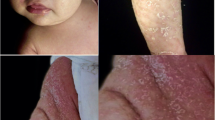Abstract
Fungal skin infections are on the rise in India, and pregnant women are not immune to them. They are one of the commonest causes of secondary pruritus in pregnancy and can worsen the quality of life. Cutaneous dermatophytic infections have seen a recent emergence as a public health problem in India with increasing incidence as well as failure to appropriately respond to treatment. Vaginal candidiasis may cause obstetric and perinatal complications such as chorioamnionitis, premature rupture of membranes, preterm labor and neonatal candidiasis. Antifungal drugs are commonly prescribed in pregnancy. The common oral antifungals used are fluconazole, ketoconazole, itraconazole, terbinafine and griseofulvin; whereas the common topical antifungals are azoles, ciclopirox oleamine, terbinafine, amongst others. There have been reports of congenital abnormalities in the fetus and spontaneous abortions attributed to oral antifungals. Prescribing antifungal drugs in pregnancy needs careful consideration. In this article, we discuss the safety profile and recommendations regarding the use of these drugs during gestation. We have performed a literature search of recent large-scale cohort, case-control, and meta-analysis studies and presented them in this review. Antifungals such as echinocandins, amphotericin B, flucytosine, etc. which are indicated for systemic mycoses are beyond the scope of this article. Finally, we have given authors’ perspective regarding the justifiable use of these antifungals in pregnant women.
Similar content being viewed by others
References
Aguin TJ, Sobel JD. Vulvovaginal candidiasis in pregnancy. Curr Infect Dis Rep. 2015;17(6):462.
Havlickova B, Czaika VA, Friedrich M. Epidemiological trends in skin mycoses worldwide. Mycoses. 2008;52(1):95.
Verma S, Madhu R. The great Indian epidemic of superficial dermatophytosis: an appraisal. Indian J Dermatol. 2017;62(3):227–36.
Bishnoi A, Vinay K, Dogra S. Emergence of recalcitrant dermatophytosis in India. Lancet Infect Dis. 2018;18(3):250–1.
Verma SB, Zouboulis C. Indian irrational skin creams and steroid-modified dermatophytosis – an unholy nexus and alarming situation. J Eur Acad Dermatol Venereol. 2018;32(11):426–7.
Sobel JD. Vulvovaginal candidosis. Lancet. 2007;369(9577):1961–71.
Ramoz LL, Patel-Shori NM. Recent changes in pregnancy and lactation labeling: Retirement of risk categories. Pharmacotherapy. 2014;34(4):389–95.
Food and Drug Administration,HHS. Content and format of labeling for human prescription drug and biological products; requirements for pregnancy and lactation labelling. Fed Regist 2014;79(233):72063–103.
King CT, Rogers PD, Cleary JD, et al. Antifungal Therapy during Pregnancy. Clin Infect Dis. 1998;27(5):1151–60.
Zhu Y, Bateman BT, Gray KJ, et al. Oral fluconazole use in the first trimester and risk of congenital malformations: population based cohort study. BMJ. 2020;369:1494–504.
Mølgaard-Nielsen D, Svanström H, Melbye M, et al. Association between use of oral Fluconazole during pregnancy and risk of spontaneous abortion and stillbirth. JAMA. 2016;315(1):58–67.
Berard A, Sheehy O, Zhao JP, et al. Associations between low- and high-dose oral fluconazole and pregnancy outcomes: 3 nested case-control studies. CMAJ. 2019;191(7):179–87.
Pilmis B, Jullien V, Sobel J, et al. Antifungal drugs during pregnancy: an updated review. J Antimicrob Chemother. 2015;70(1):14–22.
Budani MC, Fensore S, Di Marzio M, et al. Maternal use of fluconazole and congenital malformations in the progeny: A meta-analysis of the literature. Reprod Toxicol. 2021;100:42–51.
Mølgaard-Nielsen D, Pasternak B, Hviid A. Use of oral Fluconazole during pregnancy and the risk of birth defects. N Engl J Med. 2013;369:830–9.
Zhang Z, Zhang X, Zhou YY, Jiang CM, Jiang HY. The safety of oral fluconazole during the first trimester of pregnancy: a systematic review and meta-analysis. BJOG. 2019;126(13):1546–52.
Liu D, Zhang C, Wu L, Zhang L, et al. Fetal outcomes after maternal exposure to oral antifungal agents during pregnancy: A systematic review and meta-analysis. Int J Gynaecol Obstet. 2020;148(1):6–13.
U.S. FDA. FDA Drug Safety Communication: Use of long-term, high-dose Diflucan (fluconazole) during pregnancy may be associated with birth defects in infants [Internet]. USA: U.S. FDA; 2011 Aug 3 [updated 2017 Aug 4; cited 2021 May 20]. Available from: https://www.fda.gov/drugs/drug-safety-and-availability/fda-drug-safety-communicationuse-long-term-high-dose-diflucan-fluconazole-during-pregnancy-may-be
Bar-Oz B, Moretti ME, Bishai R, et al. Pregnancy outcome after in utero exposure to itraconazole: a prospective cohort study. Am J Obstet Gynecol. 2000;183(3):617–20.
De Santis M, Di Gianantonio E, Cesari E, et al. First-trimester itraconazole exposure and pregnancy outcome: a prospective cohort study of women contacting teratology information services in Italy. Drug Saf. 2009;32(3):239–44.
Dodo T, Uchida K, Hirose T, et al. Increases in discontinuous rib cartilage and fused carpal bone in rat fetuses exposed to the teratogens, busulfan, acetazolamide, vitamin A, and ketoconazole. Hum Exp Toxicol 2010; 29(6):439–50
Rotem R, Fishman B, Daniel S, et al. Risk of major congenital malformations following first-trimester exposure to vaginal azoles used for treating vulvovaginal candidiasis: a population-based retrospective cohort study. BJOG. 2018;125(12):1550–6.
Andersson NW, Thomsen SF, Andersen JT. Evaluation of association between oral and topical terbinafine use in pregnancy and risk of major malformations and spontaneous abortion. JAMA Dermatol. 2020;156(4):375–83.
Rosa FW, Hernandez C, Carlo WA. Griseofulvin teratology, including two thoracopagus conjoined twins. Lancet. 1987;329(8525):171.
Czeizel AE, Métneki J, Kazy Z, et al. A population-based case-control study of oral griseofulvin treatment during pregnancy. Acta Obstet Gynecol Scand. 2004;83(9):827–31.
Author information
Authors and Affiliations
Corresponding author
Ethics declarations
Conflict of interest
We, the authors of this study declare that no patient identity is revealed and we have no conflict of interest or financial interests for this article.
Additional information
Publisher's Note
Springer Nature remains neutral with regard to jurisdictional claims in published maps and institutional affiliations.
Dr. Madhuri A. Patel is an Hon. Clinical Associate at N. Wadia Hospital, Parel, Mumbai, India; Hon. Consultant at Police Hospital Mumbai, India and Visiting Consultant at St. Elizabeth and Masina Hospitals, Mumbai, India. Dr. Veeral M. Aliporewala is an Hon. Consultant, Police Hospital, Mumbai and Practising dermatologist at Sion, Mumbai, India. Dr. Disha A. Patel is an Assistant Professor in Department of Community Medicine at TNMC and BYL Nair Charitable Hospital, Mumbai, India.
Rights and permissions
About this article
Cite this article
Patel, M.A., Aliporewala, V.M. & Patel, D.A. Common Antifungal Drugs in Pregnancy: Risks and Precautions. J Obstet Gynecol India 71, 577–582 (2021). https://doi.org/10.1007/s13224-021-01586-8
Received:
Accepted:
Published:
Issue Date:
DOI: https://doi.org/10.1007/s13224-021-01586-8




